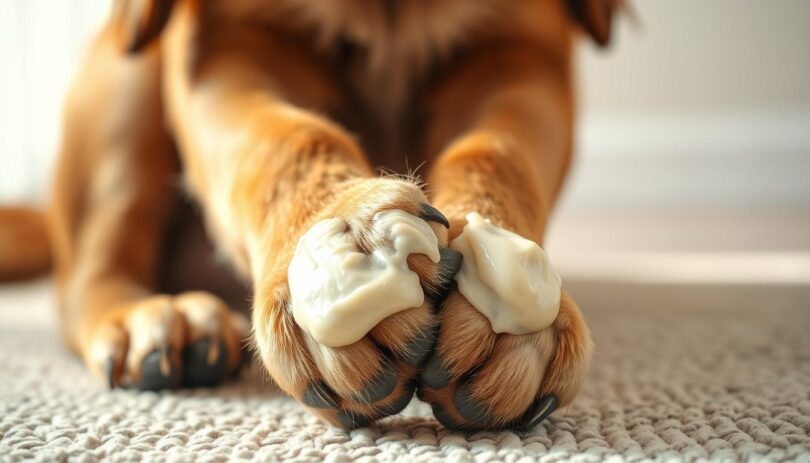Have you ever noticed your furry companion fixating on their feet like a mystery to solve? While occasional paw cleaning is normal, constant gnawing or licking could reveal more than meets the eye. This behavior often signals discomfort—and uncovering the root cause is key to restoring comfort.
Many owners overlook subtle clues like redness between toes or changes in grooming habits. Allergies, infections, and even emotional stress can drive this behavior. Pododermatitis (paw inflammation) and environmental irritants rank among common triggers, according to veterinary studies.
Early intervention matters. Left unchecked, excessive chewing may lead to infections or chronic pain. Watch for signs like limping, swollen pads, or fur discoloration—these often hint at underlying health issues needing attention.
This guide explores practical solutions, from home care adjustments to professional treatments. You’ll learn how to spot warning signs, create a paw-friendly environment, and partner with your vet for lasting relief. Let’s help your companion step forward with confidence.
Recognizing the Signs of Paw Chewing
Your pet’s paws might be trying to tell you something. Early detection of discomfort starts with understanding both visible changes and subtle shifts in behavior.
Physical Symptoms to Watch For
Swollen paw pads or redness between toes often signal trouble. Check for cracked nails, unusual warmth, or small cuts hidden beneath fur. Skin discoloration or flaky patches could indicate allergies or infections brewing beneath the surface.
Tenderness around nail beds frequently accompanies injuries. Pets might pull away when touched or favor one leg while walking. These physical cues often point to conditions like pododermatitis, requiring prompt care.
Behavioral Cues in Your Dog
Restlessness during downtime or sudden avoidance of favorite activities may hint at discomfort. Some animals lick their paws obsessively—a behavior linked to environmental irritants or anxiety.
Watch for repeated head-shaking paired with foot gnawing. This combo sometimes suggests ear infections radiating discomfort to other areas. Regular paw inspections during grooming sessions help catch issues before they escalate.
Tracking these patterns helps owners collaborate effectively with their vet. Simple daily checks—like wiping feet after walks—can prevent minor irritations from becoming major problems.
Understanding why do dogs chew their paws
Paw-focused behavior in canines often stems from multiple sources. Physical discomfort and emotional triggers frequently intertwine, creating patterns that puzzle even experienced owners. Identifying primary drivers requires careful observation and sometimes professional guidance.
Root Triggers Behind Persistent Actions
Allergic reactions top the list of culprits. Pollen, certain proteins, or flea bites can spark intense itching. This drives animals to gnaw at their feet for relief, sometimes creating raw patches.
Bacterial or yeast infections thrive in warm paw folds. Redness, odor, and greasy discharge often accompany these conditions. Pododermatitis—a skin inflammation—frequently develops when moisture gets trapped between toes.
Foreign objects like burrs or thorns lodge between pads during outdoor adventures. Even minor abrasions from rough surfaces can prompt excessive licking. Grass seeds are notorious for burrowing deep into tissue unnoticed.
Anxiety manifests physically too. Bored or stressed pets may adopt paw-chewing as a coping mechanism. Veterinarians report cases where behavioral therapy resolved issues faster than medication alone.
Each situation demands tailored solutions. Skin scrapings, allergy tests, or X-rays help pinpoint exact causes. Early intervention prevents complications like secondary infections or chronic pain cycles.
Allergies and Infections Impacting Paw Health
When your four-legged friend can't stop gnawing their feet, hidden triggers might be at play. Allergic responses and microbial imbalances frequently create a cycle of irritation that demands targeted care.
Allergic Reactions Triggering Itchiness
Histamine surges from food or environmental allergens turn paws into itch hotspots. Proteins in chicken or pollen clinging to fur often spark relentless scratching. Between toes becomes a battleground where inflammation meets constant licking.
Vets use skin scrapings and elimination diets to identify culprits. Oral antihistamines or hypoallergenic shampoos frequently bring relief. Some pets benefit from omega-3 supplements to strengthen skin barriers against irritants.
Bacterial and Yeast Infections Explained
Moisture trapped in paw folds creates playgrounds for microbes. Malassezia yeast thrives here, producing greasy discharge and a distinct odor. Redness spreads as bacteria multiply in broken skin from excessive chewing.
Topical antibiotics and antifungal wipes form the first defense line. Your vet might recommend medicated soaks or cone collars to prevent reinjury. Weekly paw inspections and drying after walks help stop infections before they start.
Home care matters. Wipe paws with gentle, pH-balanced solutions and trim toe fur to reduce debris buildup. Early intervention prevents minor issues from becoming paw-wide crises.
Managing Pain, Injury, and Joint Issues
Mobility fuels a dog's joy – but discomfort in their feet can derail even simple activities. Hidden aches often manifest through repetitive paw-focused behaviors, making early detection critical for maintaining quality of life.
Assessing Injuries and Detecting Pain
Limping or hesitation during walks often signals trouble. Check for warmth between toes or swollen joints during weekly paw inspections. Some pets become protective of sore areas, avoiding touch or shifting weight awkwardly.
Veterinarians use gait analysis and pressure tests to locate problem spots. X-rays might reveal fractures or bone spurs causing discomfort. Immediate care for cuts prevents infections that could worsen chewing habits.
Considerations for Arthritis and Joint Health
Stiffness after rest periods frequently points to arthritis. Older dogs may struggle with stairs or show reduced interest in play. Prescription NSAIDs and glucosamine supplements often improve mobility within weeks.
Home adjustments make a difference. Orthopedic beds ease pressure on hips, while non-slip rugs prevent slips on hardwood floors. Regular low-impact exercise maintains joint flexibility without straining tender feet.
Schedule vet visits if limping persists beyond 48 hours or if paws feel unusually warm. Combining medical treatment with thoughtful home care helps pets move comfortably again.
Grooming and Environmental Factors
A dog's daily habits and surroundings play crucial roles in paw health. Neglected grooming routines or hidden household hazards often spark irritation, driving pets to focus on their feet. Addressing these factors creates safer spaces for exploration and rest.
Nail and Grooming Problems
Overgrown nails alter walking posture, straining toe joints. Matted fur between pads traps dirt, creating friction sores. Regular trims prevent ingrown claws while brushing removes debris that could lead to infections.
Fleas and ticks frequently target paw areas, causing relentless itching. Monthly preventatives and post-walk checks reduce parasite risks. If biting persists, consult your vet about medicated shampoos or oral treatments.
Exposure to Irritants and Chemicals
Sidewalk de-icers and lawn fertilizers burn sensitive paw skin. Rinse feet with lukewarm water after outdoor trips—especially in urban areas. Swap harsh cleaners for vinegar-based solutions where pets roam.
Allergens like pollen cling to fur, triggering lick cycles. Weekly paw soaks with oatmeal solutions soothe inflamed skin. For persistent redness, hypoallergenic balms create protective barriers against irritants.
Simple changes make big differences. Keep grooming tools handy and store chemicals securely. Your attentiveness helps paws stay healthy through every season.
Addressing Anxiety and Behavioral Triggers
Behavioral patterns often reveal hidden emotional states in pets. Compulsive foot-focused habits frequently stem from psychological needs rather than physical discomfort. Veterinarians report that 30% of excessive paw-related behaviors link to stress responses needing behavioral solutions.
Identifying Signs of Stress in Dogs
Watch for subtle changes like increased yawning or avoidance of eye contact. Pacing along fences or sudden disinterest in playtime often signals emotional distress. Other red flags include:
– Excessive lip-licking without food nearby
– Unusual clinginess during thunderstorms
– Destructive chewing redirected toward feet
These behaviors often escalate during routine changes like moving homes or introducing new family members. Documenting patterns helps differentiate temporary boredom from chronic anxiety.
Behavioral Management and Distraction Techniques
Interactive puzzle toys filled with treats redirect focus from paws to problem-solving. Rotate chew toys weekly to maintain novelty—frozen Kongs with peanut butter work particularly well. Structured play sessions using flirt poles or scent games burn nervous energy constructively.
Positive reinforcement training strengthens calm behaviors. Reward relaxed postures with high-value snacks, gradually increasing quiet time between treats. Consistent feeding schedules and designated rest areas create predictable environments that reduce stress.
For persistent cases, consult your vet about anxiety wraps or pheromone diffusers. Severe compulsive habits may require professional trainers or anti-anxiety medication alongside behavior modification plans.
Effective Home Care and Preventative Measures
A consistent care routine transforms paw health from reactive to proactive. Simple daily habits create a strong defense against common issues, letting pets thrive in their environments. Pairing cleanliness with engaging activities addresses both physical and emotional needs.
Maintaining Paw Hygiene and Regular Checks
Post-walk paw washes remove allergens and debris. Use lukewarm water and gentle wipes, drying thoroughly between toes. Weekly nail trims prevent overgrowth that strains joints or alters gait.
Inspect pads for cracks, foreign objects, or redness during grooming. Early detection of minor cuts allows treatment with vet-approved antiseptics before infections develop. Supplements like omega-3 fatty acids strengthen skin barriers against irritants linked to allergies.
Providing Mental and Physical Stimulation
Interactive toys combat boredom that leads to destructive habits. Rotate puzzle feeders and durable chew items to maintain interest. Frozen treats in rubber toys keep pets engaged while soothing sore gums.
Regular exercise routines reduce anxiety-driven behaviors. Combine walks with scent games or agility drills tailored to your pet’s energy level. A balanced diet supports immunity—consult your vet about foods that promote skin and paw condition improvements.
Store cleaning products securely and vacuum floors weekly to minimize chemical exposure. These steps, paired with scheduled vet visits, create lasting protection against recurring problems.
A Final Word for a Happier, Healthier Pet
Companions thrive when their needs are met with care and attention. Persistent paw chewing often stems from allergies, infections, or stress—issues that improve with tailored solutions. Early detection of symptoms like redness or limping helps prevent minor irritations from escalating.
Regular vet visits ensure proper diagnosis and treatment plans. Skin issues, joint discomfort, and anxiety-driven habits often require professional guidance. Pair medical care with home strategies: clean paws after walks, use parasite preventatives, and provide engaging toys to reduce boredom.
Nutrition matters. High-quality food supports skin health and immunity, lowering allergy risks. For pets showing excessive paw licking, environmental adjustments like hypoallergenic bedding or calming sprays can make a difference.
Stay observant and proactive. Simple routines—weekly paw checks, mental stimulation, and prompt vet consultations—build lasting comfort. With patience and expert-backed care, every pet can enjoy active days and peaceful nights.










Leave a Comment